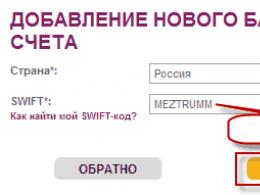Requirements for the procedure for transmitting traffic in the telephone network - Rossiyskaya Gazeta. Tariffs Organization of physical chain
TELEPHONE NETWORK OPERATORS*
1. Call termination services to the network of another telecom operator:
a) international call termination service (activities aimed at ensuring the passage of traffic from the point of interconnection at the international level of interconnection to user (terminal) equipment connected to the communication network of an operator located outside the territory Russian Federation);
b) long-distance call termination service (activities aimed at ensuring the passage of traffic from the point of interconnection at the intercity level of connection to user (terminal) equipment connected to the communication network of another telecom operator);
c) zone call termination service (activities aimed at ensuring the passage of traffic from the connection point at the zone level of connection to user (terminal) equipment connected to the communication network of another telecom operator);
d) local call termination services (activities aimed at ensuring the passage of traffic from the point of connection at the local or subscriber level of connection to user (terminal) equipment connected to the communication network of another telecom operator):
local call termination service at the communication center;
local call termination service at an adjacent communication center;
2. Call termination services to the telecom operator's network(activities aimed at ensuring the passage of traffic from the point of connection to the telecom operator’s network to the user (terminal) equipment connected to the telecom network of the same operator):
a) zonal call termination service to the telecom operator’s network;
b) local call termination service to the telecom operator’s network:
local call termination service at the telecom operator's communication center;
local call termination service at an adjacent communication center of a telecom operator;
local call termination service to a communication network with one transit node;
local call termination service to a network with 2 or more transit nodes.
3. Call transit services(activities of a telecom operator aimed at passing traffic through its communication network between the communication networks of 2 other telecom operators or between different parts of the communication network of one telecom operator):
a) international call transit services:
international transit service for a call not intended to be terminated on the territory of the Russian Federation;
international call transit service intended for termination on the territory of the Russian Federation;
b) long-distance call transit service;
c) zonal call transit service;
d) local call transit service.
4. Call origination services(activities aimed at ensuring the passage of traffic from user (terminal) equipment connected to the communication network of this or another telecom operator, from the point of connection to the network of this operator communications when providing access to communication services provided by other fixed-line network operators telephone communication or data network operators):
a) long-distance call initiation service;
b) zone call initiation service;
c) local call initiation service:
Local call initiation service at a communication center;
Local call initiation service at an adjacent communication center;
Local call origination service with one transit node;
Local call origination service with 2 or more transit nodes.
INTRODUCTION……………………………………………………………………………………….3
1. THEORETICAL FOUNDATIONS OF MARKET PRICING………..5
1.1. The essence of price. Basic approaches to setting prices………………………5
1.2. Types and functions of prices. Aspects of pricing in the field of infocommunications
tions………………………………………………………………………………8
2. CHARACTERISTICS OF THE CURRENT PRICING SYSTEM
IN INFO COMMUNICATIONS……………………………………………………11
2.1. The essence and classification of tariffs and prices for infocommunication services
services………………………………………………………………………………..11
2.2. Assessment of the levels and dynamics of tariffs and prices in the infocommunications sector...15
3. STRATEGIES AND TACTICAL TECHNIQUES FOR PRICING
MARKET OF INFO COMMUNICATION SERVICES……………………………………………………..20
3.1. Characteristics of pricing strategies in infocommunications…………20
3.2. Pricing tactics to stimulate demand for
infocommunication services………………………………………………………24
4. METHODS FOR DETERMINING COST AND ECONOMICAL
REASONABLE COSTS FOR FORMING PRICES AND TARIFFS………28
4.1. Composition and structure of prices and tariffs for infocommunication services……….28
4.2. The essence and methodology for determining economically justified costs for
provision of information and communication services………………………………………………………..30
5. FACTORS OF MARKET PRICING AND CONSUMPTION THEORY
BODILY BEHAVIOR………………………………………………………...36
5.1. Factors of market pricing in the infocommunications industry………..36
5.2. Using the theory of consumer behavior in practice
pricing of infocommunication companies……………………………39
6. METHODS OF MARKET PRICING IN THE INFOCOM SECTOR
MUNICATION…………………………………………………………………………………….43
6.1. Methods based on production cost accounting………………………43
6.2. Competitive pricing methods………………………………………..46
6.3. Econometric methods for determining prices and tariffs………………………..47
7. METHODS FOR SETTING TARIFFS AND PRICES IN CONDITIONS
STATE REGULATION OF PRICING………………51
7.1. Policy pricing in the telecommunications sector…………………………51
7.2. Marginal pricing method……………………………………………………….53
8. MECHANISM OF STATE REGULATION OF PRICING
VANIA IN THE INFO COMMUNICATIONS SECTOR……………………………………………………...56
8.1. Objectives and procedure for state regulation of pricing in
infocommunications………………………………………………………………..56
8.2. Methodology for calculating tariffs and tariff plans for local telephone services
no connection………………………………………………………………………………...63
8.3. Principles and procedure for state regulation of prices for services
connections and traffic transmission services………………………………………………………68
9. FEATURES OF FORMATION OF TARIFFS FOR INNOVATION
SERVICES……………………….………………………………………………………………...73
APPLICATIONS……………………………………………………………………………….82
In preparation this section materials used teaching aid V.V. Gerasimenko. Pricing. – M.: INFRA-M, 2005. – 442 p. – (Series “Textbooks of the Faculty of Economics of Moscow State University named after M.V. Lomonosov)
* Approved by Decree of the Government of the Russian Federation dated October 24, 2005 No. 637 “On government regulation tariffs for public electric and public postal service»
* In accordance with Appendix No. 1 to the Rules for connecting telecommunication networks and their interaction. Approved by Decree of the Government of the Russian Federation of March 28, 2005 No. 161.
** In accordance with Appendix No. 2 to the Rules for connecting telecommunication networks and their interaction. Approved by Decree of the Government of the Russian Federation of March 28, 2005 No. 161.
dated December 29, 2005 N 828)
1. Call termination services to the network of another telecom operator:
a) international call termination service (activities aimed at ensuring the passage of traffic from the point of interconnection at the international level of connection to user (terminal) equipment connected to the communication network of an operator located outside the territory of the Russian Federation);
b) long-distance call termination service (activities aimed at ensuring the passage of traffic from the point of interconnection at the intercity level of connection to user (terminal) equipment connected to the communication network of another telecom operator);
c) zone call termination service (activities aimed at ensuring the passage of traffic from the connection point at the zone level of connection to user (terminal) equipment connected to the communication network of another telecom operator);
d) local call termination services (activities aimed at ensuring the passage of traffic from the point of connection at the local or subscriber level of connection to user (terminal) equipment connected to the communication network of another telecom operator):
local call termination service at the communication center;
local call termination service at an adjacent communication center;
local call termination service to a communication network with one transit node;
local call termination service to a communication network with 2 or more transit nodes.
2. Call termination services to the telecom operator’s network (activities aimed at ensuring the passage of traffic from the point of connection to the telecom operator’s network to the user (terminal) equipment connected to the telecom network of the same operator):
a) zonal call termination service to the telecom operator’s network;
b) local call termination services to the telecom operator’s network:
local call termination service at the telecom operator's communication center;
local call termination service at an adjacent communication center of a telecom operator;
local call termination service to a telecom operator's network with one transit node;
local call termination service to a telecom operator's network with 2 or more transit nodes.
a) international call transit services:
international transit service for a call not intended to be terminated on the territory of the Russian Federation;
international transit service for a call intended to terminate on the territory of the Russian Federation;
b) long-distance call transit service;
c) zonal call transit service;
d) local call transit service.
4. Call initiation services (activities aimed at ensuring the passage of traffic from user (terminal) equipment connected to the communication network of this or another telecom operator to the point of connection to the network of this telecom operator when providing access to communication services provided by other fixed-line network operators telephone or data network operators):
(as amended by Decree of the Government of the Russian Federation dated December 29, 2005 N 828)
a) long-distance call initiation service;
b) zone call initiation service;
c) local call initiation services:
local call initiation service at a communication center;
local call initiation service at an adjacent communication center;
local call origination service with one transit node;
local call initiation service with 2 or more transit nodes.
Vaipan Viktor Alekseevich
Managing partner of the Justitsinform Consulting Group, editor-in-chief of the journals "Law and Economics" and "Bulletin of the Arbitration Court" of the city of Moscow, executive secretary of the Assembly of Current Legislation of the city of Moscow, candidate of legal sciences, lawyer of the Moscow Bar Association. Specialist in civil law, business purchase and sale transactions.
Managed, implemented and coordinated large legal projects, primarily in the field of communications and transport. As an expert or leader of expert groups, he participated in the preparation of legal opinions on issues of economic activity and ongoing consulting for Russian and foreign companies of various forms of ownership. Coordinated the preparation of a number of federal bills and other regulatory legal acts. Participated in many complex arbitration cases.
In the activities of telecom operators, difficulties often arise related to the interpretation of the provisions of the Communications Law in terms of definitions of key terms. One of these problems is identifying the relationship between the concepts of traffic transmission services and communication services.
Some experts believe that traffic transmission services belong to communication services. This approach seems erroneous. The confusion of these concepts is not based on a literal interpretation Federal Law dated July 7, 2003 N 126-FZ “On Communications” (as amended by Federal Law dated March 3, 2006 N 32-FZ) (hereinafter referred to as the Communications Law), does not correspond to its meaning and may entail legal consequences that are not included in the provisions of communications legislation. The most obvious negative consequence of recognizing traffic transmission services as communication services is the need for telecom operators to obtain a special license for the paid provision of traffic transmission services, which clearly does not comply with the current communications legislation. Consequently, if there is a technical possibility, but in the absence of a license containing permission to carry out activities to transmit traffic, the communications organization will not be able to transmit the traffic of telecom operators for a fee. Such conclusions are unlawful. Current communications legislation provides for significant differences between traffic transmission services and communication services.
First of all, let's compare the language of the Communications Law regarding basic definitions.
In accordance with Art. 2 of the Communications Law, telecommunications are any emission, transmission or reception of signs, signals, voice information, written text, images, sounds or messages of any kind over radio, wire, optical and other electromagnetic systems. Traffic is the load created by the flow of calls, messages and signals arriving at communications facilities. Passing traffic is the process of establishing a connection and transmitting information between communication networks.
Communication service is the activity of receiving, processing, storing, transmitting, delivering telecommunication messages or postal items. A user of a communication service can be any person ordering and (or) using communication services.
Traffic transmission service is an activity aimed at meeting the needs of telecom operators to transmit traffic between interacting telecommunication networks. A communication network is a technological system that includes communication facilities and lines and is intended for telecommunications or postal communications.
Thus, traffic transmission is carried out by telecom operators through telecommunication networks. Accordingly, users of traffic transmission services are only telecom operators who do not fall under the definition of a subscriber given in the Law.
Based on the above formulations, we can conclude that regarding services for traffic transmission and communication services, the legislation of the Russian Federation provides for various legal regimes.
- Traffic transmission services in the Communications Law act as independent services and are not equated to communication services.
Article 2 of this Law provides different definitions of communication services and traffic transmission services. The content of these definitions does not coincide.
The essence of communication services lies in the full reception, processing, storage, transmission or delivery of individual information ordered by a specific user.
At the same time, traffic transmission is the satisfaction of the needs of interacting telecom operators in their full-fledged activities in providing communication services to individual users. The transmission of traffic is not in the nature of a complete communication service provided to the end user.
- Traffic transmission services are provided only in the interests of telecom operators. Communication services can be provided to any interested parties, including one telecom operator to another telecom operator.
According to Art. 2 of the Law on Communications, a user of communication services can be any person ordering and (or) using communication services. As a narrower subcategory of users, subscribers of communication services are distinguished as users of communication services with whom an agreement has been concluded for the provision of such services by allocating a subscriber number or a unique identification code for these purposes.
- Traffic transmission services are reflected in the interconnection agreement or in the interconnection agreement.
Communication services are reflected in the contract for the provision of communication services.
These agreements are different legal grounds activities to provide the services provided for therein and differ in their essential conditions.
- Traffic transmission services, unlike communication services, are not subject to licensing (not included in the List of licensed services defined by Government Decree No. 87 of February 18, 2005). Neither the Communications Law nor the Federal Law of August 8, 2001 N 128-FZ “On licensing of certain types of activities” provide for the need to license traffic transmission services. Only communication services specified in Resolution No. 87 are licensed, the list of which is not subject to broad interpretation without amending it in the prescribed manner.
The Communications Law provides for traffic transmission as an independent service. According to this Law, the right to provide such a service is granted to telecom operators. In accordance with Decree of the Government of the Russian Federation of March 28, 2005 N 161, the procedure for transmitting traffic through telecommunication networks is regulated by telecom operators independently in a contractual manner, without obtaining a license for this type of activity. In this case, the requirements for the procedure for transmitting traffic are established by the Ministry of Information and Communications of Russia within its competence (clause 6 of the Rules for connecting telecommunication networks and their interaction).
According to the Communications Law, only communication services are subject to licensing. Despite the fact that Ch. 6 of the Law is entitled “Licensing of activities in the field of provision of communication services and confirmation of compliance of communication means”, it should be emphasized that in Art. 29 of the Law on Communications is not about licensing all paid services, but about licensing only paid communication services.
The absence in Decree of the Government of the Russian Federation N 87 of such a licensed service as traffic transmission does not mean a ban on the provision of these services in the Russian Federation. The telecom operator has the right to carry out this activity without a license.
According to Art. 1 and 49 of the Civil Code of the Russian Federation legal entities are free to carry out any activity if this does not contradict the law and their constituent documents, and civil rights can only be limited by law. A ban on engaging in certain types of activities or their licensing can only be established by law.
Licensing of traffic transmission services is not provided for by the Communications Law and cannot be established in Decree of the Government of the Russian Federation No. 87 as a by-law, because:
in accordance with the law, only communication services are subject to licensing, and not traffic transmission services; accordingly, restrictions in the form of licensing the provision of traffic transmission services are not allowed;
licensing of traffic transmission services cannot be subject to regulation by Resolution No. 87, which concerns only the licensing of communication services;
the introduction of licensing of traffic transmission services is possible only by introducing appropriate amendments to the Communications Law.
In addition, it should be noted that the note to the List license conditions carrying out activities in the field of providing relevant communication services also allows for the simultaneous provision of communication services and other services that are technologically inextricably linked with communication services and aimed at increasing their consumer value, unless a separate license is required for this.
1. The provisions of a public contract in relation to operators occupying a significant position in the public communications network are applied to the agreement on the connection of telecommunication networks, which defines the conditions for the provision of connection services, as well as the associated obligations for the interaction of telecommunication networks and the transmission of traffic. At the same time, consumers of connection services and traffic transmission services for the purposes of this article are public communication network operators.
An operator occupying a significant position in the public communications network, in order to ensure non-discriminatory access to the communications services market in similar circumstances, is obliged to establish equal conditions for connecting telecommunication networks and passing traffic for communications operators providing similar services, as well as provide information and services to these communications operators connection services and traffic transmission services on the same terms and of the same quality as for its structural divisions and (or) affiliates.
An operator that occupies a significant position in the public communications network in the territories of several constituent entities of the Russian Federation establishes the conditions for connecting telecommunication networks and transmitting traffic separately on the territory of each constituent entity of the Russian Federation.
2. The refusal of an operator occupying a significant position in the public communications network to conclude an agreement on the connection of telecommunication networks is not allowed, except in cases where the connection of telecommunication networks and their interaction contradicts the terms of licenses issued to telecommunication operators or regulatory legal acts defining construction and operation of a unified telecommunications network of the Russian Federation.
3. The procedure for connecting telecommunication networks and their interaction with the telecommunication network of an operator occupying a significant position in the public communication network, and its responsibilities when connecting telecommunication networks and interacting with telecommunication networks of other communication operators, telecommunication networks of owners of special-purpose communication networks are determined in accordance with rules approved by the Government of the Russian Federation.
Operators that occupy a significant position in the public communications network, based on the rules for connecting telecommunication networks and their interaction, establish conditions for connecting other telecommunication networks to their telecommunication network in terms of use network resources and traffic transmission, including general technical, economic, information conditions, as well as conditions defining property relations.
The conditions for connecting telecommunication networks must include:
technical requirements relating to the connection of telecommunication networks;
volume, procedure and timing of work on connecting telecommunication networks and their distribution between interacting telecom operators;
the procedure for passing traffic through telecommunication networks of interacting telecom operators;
location of connection points of telecommunication networks;
list of connection services and traffic transmission services provided;
the cost of connection services and traffic transmission services and the payment procedure for them;
the order of interaction of telecommunication network management systems.
Operators that occupy a significant position in the public communications network, within seven days after establishing the conditions for connecting telecommunication networks, publish the specified conditions and send them to the federal executive body in the field of communications.
In the event that the federal executive body in the field of communications, independently or at the request of telecom operators, discovers a discrepancy between the conditions for connecting other telecommunication networks to the telecommunication network of an operator occupying a significant position in the public communications network, and the transmission of traffic through it with the rules specified in paragraph one of this clause, or regulatory legal acts, the specified federal body sends to the operator occupying a significant position in the public communications network a reasoned order to eliminate these inconsistencies. This order must be accepted and implemented by the telecom operator who received it within thirty days from the date of its receipt.
(see text in the previous edition)
The newly established conditions for connecting other telecommunication networks to the telecommunication network of the operator occupying a significant position in the public communications network and passing traffic through it are published by the operator occupying a significant position in the public communications network and are sent to the federal executive body in the field of communications in the manner provided for by this article.
When putting into operation new communication means, introducing new technological solutions in its telecommunication network, decommissioning or upgrading outdated communication means, which significantly affects the conditions for connecting other telecommunication networks and passing traffic through the telecommunication network of an operator that occupies a significant position in the general communication network use, the specified telecommunications operator has the right to establish new conditions for connecting other telecommunication networks to its network in the manner prescribed by this article. At the same time, the conditions for connecting telecommunication networks cannot change more than once a year.
4. An operator occupying a significant position in the public communications network shall consider the communications operator’s requests for concluding an agreement on the connection of telecommunication networks within a period not exceeding thirty days from the date of receipt of such an application. An agreement on the connection of telecommunication networks is concluded in writing by drawing up one document in accordance with civil law, signed by the parties, within a period not exceeding ninety days from the date of receipt of the application. Failure to comply with the form of such an agreement entails its invalidity.
5. The federal executive body in the field of communications maintains and publishes a register of operators occupying a significant position in the public communications network.
6. The federal executive body in the field of communications is obliged to consider requests from telecommunications operators on issues of connecting telecommunication networks and their interaction within sixty days from the date of receipt of these requests and publish the decisions taken on them.
In case of failure of the operator occupying a significant position in the public communications network to comply with the instructions of the federal executive body in the field of communications on issues of connection of telecommunication networks and their interaction, as well as evasion of the operator occupying a significant position in the public communications network from concluding an agreement on interconnection telecommunication networks, the other party has the right to go to court with a demand to compel the conclusion of an agreement on the connection of telecommunication networks and compensation for losses caused.
Registration N 6917
In order to implement the requirements of paragraph 3 of Article 26 of the Federal Law of July 7, 2003 “On Communications” (Collection of Legislation of the Russian Federation, 2003, No. 28, Art. 2895), I order:
1. Approve the attached requirements for the procedure for passing traffic in telephone network public communications.
2. Put into effect the attached requirements for the procedure for transmitting traffic in the public telephone network from January 1, 2006.
4. Entrust control over the implementation of this order to the Deputy Minister information technologies and communications of the Russian Federation B.D. Antonyuk.
Minister
L. Reiman
Application
Requirements for the procedure for transmitting traffic in the telephone network public communications
I. The procedure for passing trafficwhen providing local, intrazonal, intercity services and international telephone communications, mobile radio communications, mobile radiotelephone communications, mobile satellite radio communications
1. Traffic transmission when providing local telephone services is carried out in the following order:
b) communication nodes of the local telephone network (networks) operating within the territory of a municipal entity, which is an urban or rural settlement, municipal district, or federal city;
c) user (terminal) equipment.
2. Traffic transmission when providing intrazonal telephone services is carried out in the following order:
a) user (terminal) equipment;
d) communication nodes of the local telephone network (networks);
e) user (terminal) equipment;
2) between user (terminal) equipment connected to a fixed telephone network and a subscriber station (subscriber device) connected to a mobile network, when the subscriber numbers of the calling and called subscriber and (or) user are included in the numbering resource, respectively geographically defined and geographically not defined numbering zones assigned to the same subject of the Russian Federation:
a) user (terminal) equipment;
b) communication nodes of the local telephone network (networks);
c) communication nodes of the fixed zonal telephone network (networks) operating within the territory of a constituent entity of the Russian Federation;
d) communication nodes of the mobile communication network;
e) subscriber station (subscriber device);
a) user (terminal) equipment;
b) communication nodes of the local telephone network (networks);
d) communication nodes of one mobile communication network operating within the territory of one constituent entity of the Russian Federation;
f) communication nodes of another mobile network;
a) user (terminal) equipment;
b) communication nodes of the local telephone network (networks);
c) communication nodes of the network (networks) of fixed zonal telephone communications;
d) communication nodes of a mobile communication network operating within the territory of one constituent entity of the Russian Federation;
e) transit long-distance communication nodes of the network (networks) of long-distance and international telephone communications;
3. Traffic transmission when providing long-distance telephone services is carried out in the following order:
1) between user (terminal) equipment connected to the fixed telephone network:
a) user (terminal) equipment;
b) communication nodes of the local telephone network (networks);
c) communication nodes of the fixed zonal telephone network operating within the territory of one constituent entity of the Russian Federation;
e) communication nodes of the fixed zonal telephone network operating within the territory of another constituent entity of the Russian Federation;
f) communication nodes of the local telephone network (networks);
g) user (terminal) equipment;
2) between user (terminal) equipment connected to a fixed telephone network and a subscriber station (subscriber device) connected to a mobile network, when the subscriber numbers of the calling and called subscriber and (or) user are included in the numbering resource, respectively geographically defined and geographically undefined numbering zones assigned to various constituent entities of the Russian Federation:
a) user (terminal) equipment;
b) communication nodes of the local telephone network (networks);
c) communication nodes of the fixed zonal telephone network operating within the territory of a constituent entity of the Russian Federation;
d) transit long-distance communication nodes of the network (networks) of long-distance and international telephone communications;
e) communication nodes of a mobile communication network operating on the territory of the same constituent entity of the Russian Federation;
f) subscriber station (subscriber device);
a) user (terminal) equipment;
b) communication nodes of the local telephone network;
e) transit long-distance communication nodes of the network (networks) of long-distance and international telephone communications;
f) communication nodes of the mobile communication network;
g) subscriber station (subscriber device);
a) user (terminal) equipment;
b) communication nodes of the local telephone network (networks);
c) communication nodes of the fixed zonal telephone network;
d) transit long-distance communication nodes of the network (networks) of long-distance and international telephone communications;
f) communication nodes of the network (networks) of a foreign state;
g) subscriber station (subscriber device).
4. Traffic transmission when providing international telephone services is carried out in the following order:
1) between user (terminal) equipment connected to the fixed telephone network:
a) user (terminal) equipment;
b) communication nodes of the local telephone network (networks);
e) communication nodes of the fixed telephone network of a foreign state;
e) user (terminal) equipment.
2) between user (terminal) equipment connected to the fixed telephone network and a subscriber station (subscriber device) connected to the mobile network:
a) user (terminal) equipment;
b) communication nodes of the local telephone network (networks);
c) communication nodes of the fixed zonal telephone network operating within the territory of a constituent entity of the Russian Federation, in which the user (terminal) equipment of the caller and (or) user is located;
d) transit long-distance and (or) international communication nodes of the network (networks) of long-distance and international telephone communications;
e) communication nodes of the mobile communication network of a foreign state;
f) subscriber station (subscriber device).
5. The transmission of traffic between subscriber stations (subscriber devices) connected to the mobile communication network (networks) when providing mobile radiotelephone communications or mobile radio communications, or mobile satellite radio communications services is carried out in the following order:
a) subscriber station (subscriber device);
b) communication centers of various mobile communication networks operating within the territory of one constituent entity of the Russian Federation;
c) subscriber station (subscriber device);
a) subscriber station (subscriber device);
b) communication nodes of one mobile network;
c) communication nodes of the long-distance and international telephone network;
d) communication nodes of another mobile network;
e) subscriber station (subscriber device).
II. The procedure for passing traffic when providing services for passing traffic
6. Traffic transmission for the provision of international call termination services is carried out in the following order:
c) point of connection of the long-distance and international telephone network;
d) communication node(s) that is part of the public communication network of a foreign state.
7. Traffic transmission for the provision of long-distance call termination services to the fixed telephone network is carried out in the following order:
a) point of connection of the long-distance and international telephone communication network;
c) communication node (nodes) of the fixed zonal telephone network;
d) communication node (nodes) of the local telephone network (networks).
8. Traffic transmission for the provision of long-distance call termination services to the mobile network is carried out in the following order:
a) point of connection of the long-distance and international telephone communication network;
b) transit international communication node (nodes), or transit long-distance communication node (nodes), or transit long-distance communication node (nodes) and transit long-distance communication node (nodes);
c) communication node(s) of the mobile communication network.
9. Traffic transmission for the provision of zonal call termination services to the fixed telephone network is carried out in the following order:
c) communication node (nodes) of the local telephone network (networks).
10. Traffic transmission for the provision of zonal call termination services to the mobile network is carried out in the following order:
a) point of connection of the mobile communication network;
b) communication node(s) of the mobile communication network.
11. Traffic transmission for the provision of local call termination service is carried out in the following order:
b) communication node (nodes) of the local telephone network (networks).
12. The passage of traffic for the provision of international transit services for a call not intended to be terminated on the territory of the Russian Federation is carried out in the following order:
a) point of connection of the long-distance and international telephone communication network;
b) transit international communication center(s);
13. The passage of traffic for the provision of international transit services for a call intended to be terminated on the territory of the Russian Federation is carried out in the following order:
a) point of connection of the long-distance and international telephone communication network;
b) transit international communication center (nodes) and transit intercity communication center (nodes) or transit international communication center (nodes);
c) point of connection of the long-distance and international telephone network.
14. Traffic transmission for the provision of long-distance call transit services is carried out in the following order:
a) point of connection of the long-distance and international telephone communication network;
b) transit long-distance communication center(s);
c) point of connection of the long-distance and international telephone network.
15. Traffic transmission for the provision of zonal call transit services is carried out in the following order:
a) point of connection of the fixed zonal telephone network;
b) communication node (nodes) of the fixed zonal telephone network;
c) point of connection of the fixed zonal telephone network.
16. Traffic transmission for the provision of local call transit services is carried out in the following order:
a) point of connection of the local telephone network;
b) communication node(s) of the local telephone network;
c) point of connection of the local telephone network.
17. When providing the call initiation service, traffic is passed in the reverse order specified in paragraphs 6-11 of these requirements.






